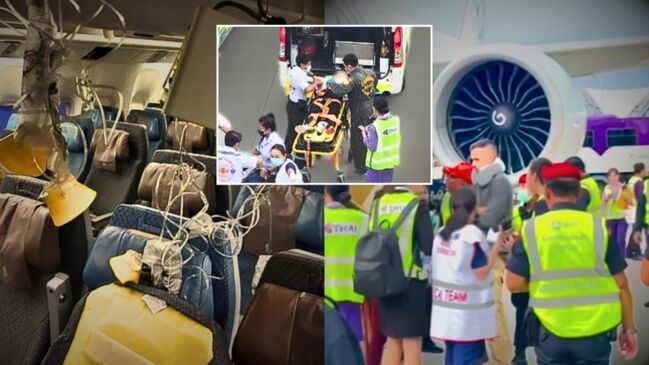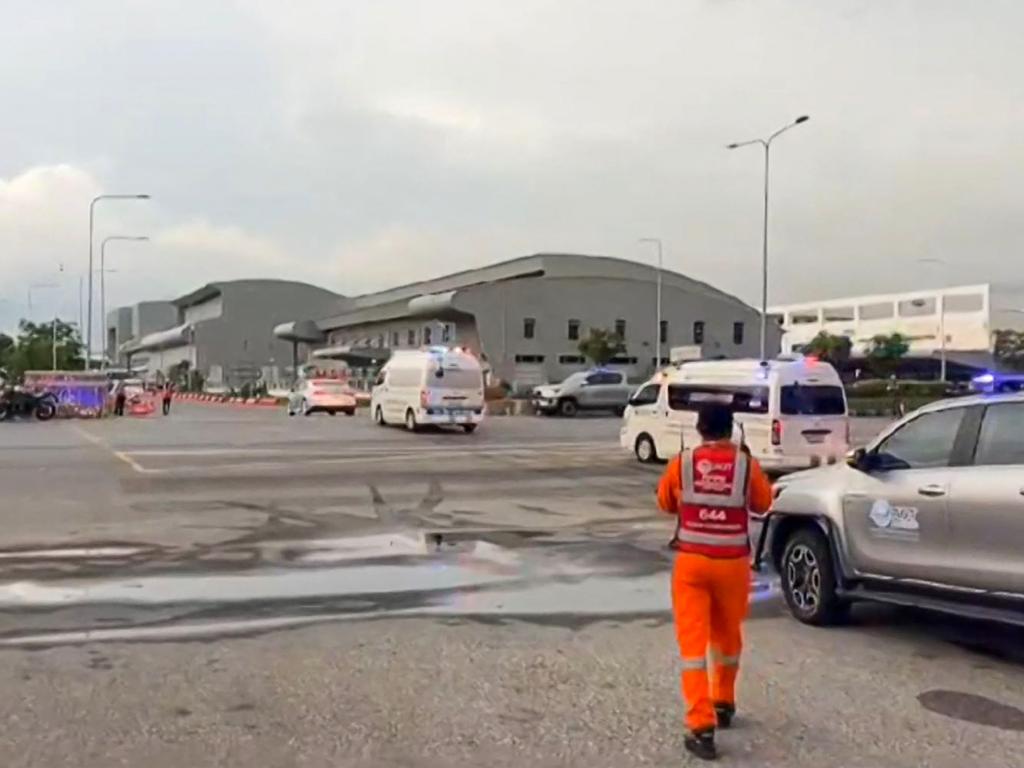‘Flung to the roof’: Aussie’s plane plunge hell
An Aussie woman has opened up about the terrifying moment she was “flung to the roof” of a Singapore Airlines jet when it abruptly plunged 2000m in the sky.

A Melbourne woman has described the terrifying moment she was “flung to the roof” of a Singapore Airlines jet when it plunged 2000m in the sky.
Teandra Tukhunen, 30, who had her left arm in a sling, spoke to Sky News from Bangkok’s Samitivej Srinakarin Hospital.
She said she was asleep and “was woken up because I was thrown to the roof and then to the floor”.
Ms Tukhunen said she didn’t have time to put her seatbelt on after the sign came on. “Pretty much immediately, straight after that I was flung to the roof, before I had time to put my seatbelt on unfortunately,” she said.
“It was just so quick, over in a couple of seconds and then you’re just shocked. Everyone’s pretty freaked out.”
Asked if it was scary, she said, “Life happens. Things happen. The pilots saved our lives, that’s all that matters in the end.”
Almost 60 Australians were on-board flight SQ321 from London to Singapore on Tuesday when the Boeing 777-300ER struck horror turbulence 11 hours into the journey, sending passengers smashing into the ceiling as the plane dropped thousands of feet.
One man, Geoff Kitchen, 73, died on board after suffering a heart attack as the turbulence hit while another 71 people were injured before the plane made an emergency landing in Bangkok, Thailand.


Pilot’s disturbing theory about plunge
Tim Atkinson, an aviation consultant and a former aircraft accident investigator, told the BBC the large size of the aircraft made the incident “very significant”.
“Small aircraft are more susceptible to severe turbulence and encounters resulting in injuries or indeed death,” he said.
Mr Atkinson claimed turbulence was becoming more common and severe because of climate change.
Most turbulence occurs in cloud and is fairly mild, but can be more severe in large clouds such as the cumulonimbus thunderstorm cloud.
However another type of turbulence called “clear air” turbulence, which typically occurs in the jet stream around 40,000-60,000 feet, is difficult to detect and can cause sudden emergencies.
Speaking to Sky News, Mr Atkinson said “it’s fairly clear” the Singapore Airlines flight “encountered atmospheric turbulence”.
He noted that the area — called the Intertropical Convergence Zone — is “renowned among pilots, and I dare say passengers, for turbulence”.
“Despite abundant caution occasionally, there’s turbulence ahead which can’t be identified, and the unfortunate result of an encounter is injury and, very rarely, fatality,” he said.

Mr Atkinson also noted that the larger the aircraft, “the worse the atmospheric perturbation, the disruption in the smoothness of the atmosphere, needs to be to cause major problems”.
Scientists have long warned that climate change is likely to increase so-called clear air turbulence, which is invisible to radar.
A 2023 study found the annual duration of clear air turbulence increased 17 per cent from 1979 to 2020, with the most severe cases increasing over 50 per cent.
Speaking to Fox News, Captain Shem Malmquist, a pilot and instructor at the Florida Institute of Technology College of Aeronautics, suggested another theory.
“I have extensive experience flying Boeing 777s over the Bay of Bengal, the exact area that this occurred,” he said.
“When you look at a turbulence-type event, there’s only a few factors that can cause turbulence of this nature.”
Mr Malmquist said it could have been caused by a fast-flowing jet stream, but those are “normally closer to the poles, relatively speaking”.
He suggested it could also have been caused by flying close to a thunderstorm.
“One of the things that caught my eye is the knowledge that when you fly over the area of Bay of Bengal, it’s warm tropical waters, the thunderstorms don’t manifest the way they do in other parts of the world,” he said.
“Most pilot training is based on the kind of thunderstorms we see in North America. But thunderstorms over warm oceanic areas manifest significantly differently, and because of that the way the pilots are trained and even some of the automated radar algorithms can miss it and not depict the storm, and the next thing they know they’re flying right into it.”

Mother’s chilling text
Josh Barker was one of the 211 passengers aboard the Boeing. As turbulence hit, the man feared the worst — and sent a frantic text to his mum at 9.10am on May 21.
It read: “I don’t want to scare you, but I’m on a crazy flight. The plane is making an emergency landing… I love you all.”
Speaking to the BBC, Mr Barker’s mother Alison said receiving the lone text was “petrifying”
“It was terrifying. I didn’t know what was going on,” she said, adding he was en route to Bali.
“We didn’t know whether he’d survived, it was so nerve-wracking. It was the longest two hours of my life. It was awful; it was petrifying.”
Mrs Barker said while her son was lucky to survive the ordeal, he was still in “a lot of pain” having sustained injuries to his teeth and fears the near-death experience will have a lasting impact.

Images capture aftermath of freak turbulence
Meanwhile, shocking footage has revealed the aftermath of turbulence inside the cabin of the aircraft, as a pilot reveals a disturbing theory about the “very significant” incident.
Footage from inside the plane shows the scale of the destruction — an entire ceiling section of a food preparation area destroyed with wreckage hanging down, debris strewn all throughout the aisles and walkways, multiple blood stains visible on upper sections of the cabin and overhead lockers.
Other video and images taken on-board showed bleeding and terrified passengers and crew waiting to land, with multiple ceiling panels broken and gas masks dangling.

An initial data analysis by the aviation tracking service Flightradar24 suggested the flight experienced more than one minute of extreme turbulence at around 11,300 metres (37,000 feet) over Myanmar, during which it violently rose and plunged several times.
The aircraft later affected a sharp, controlled descent and diverted to Bangkok.
A CNN Weather analysis also found it was likely the flight encountered rapidly developing thunderstorms over southern Myanmar.
Tropical thunderstorms typical for this time of year, which can form quickly in the early afternoon as the land heats up, may not appear on radar in their earliest stages, the broadcaster noted.
“In terms of exactly what happened, it’s too early to tell,” US-based aerospace safety expert Anthony Brickhouse told AFP. “But I think passengers are too casual on board commercial aircraft. The moment the captain turns off the seatbelt sign, people literally unbuckle.”

Passengers describe moment plane dropped
Malaysian student Dzafran Azmir, 28, told Reuters he started bracing himself when the aircraft began tilting up and shaking.
“Suddenly there was a very dramatic drop, so everyone seated and not wearing a seatbelt was launched immediately into the ceiling,” he said.
“Some people hit their heads on the baggage cabins overhead and dented them, they hit the places where lights and masks are, and broke straight through. The crew and people inside lavatories were hurt the most because we discovered people just on the ground, not able to get up. There were a lot of spinal and head injuries.”
Andrew Davies, a British passenger aboard the Boeing 777-300ER, told BBC Radio that the plane “suddenly dropped” and there was “very little warning”.
“During the few seconds of the plane dropping, there was an awful screaming and what sounded like a thud,” he said, adding that he helped a woman who was “screaming in agony” with a “gash on her head”.
He described seeing people with head lacerations and bleeding ears. “I was covered in coffee. It was incredibly severe turbulence”.
Asked what passengers could do to protect themselves, Mr Malmquist said that “absent any real advance warning ... the best thing you can possibly do is any time you’re seated, you keep the seatbelt on”.
“It does not have to be snug tight ... but it should be tight enough so if you do encounter something like this you won’t go airborne and hit the ceiling, because that is literally what happens,” he said.
“Unfortunately the cabin crew who are up walking around, there’s very little they can do ... there’s heavy carts and all those things can become airborne in a moment.”
Most of the injured passengers on the flight suffered blows to the head, said the director of Bangkok’s Suvarnabhumi Airport, Kittipong Kittikachorn, who confirmed the age and nationality of the deceased man.
Emergency vehicles raced onto the tarmac at the Thai capital’s main airport with lights flashing and sirens blaring after the plane touched down at 3.45pm local time (6.45pm AEST).
“At 3.35pm the airport received a distress call from the Singapore Airlines flight saying there were passengers on board injured by turbulence, and requesting an emergency landing,” Suvarnabhumi Airport said in a statement.
“The plane landed at the airport and the medical team was sent to treat all the injured.”
Flight SQ321 had taken off from London’s Heathrow Airport and “encountered sudden extreme turbulence” at 37,000 feet over Myanmar’s Irrawaddy Basin, according to Singapore Airlines.
It confirmed in a statement that there were “injuries and one fatality” and said there had been a total of 211 passengers and 18 crew on board.

Singapore Prime Minister Lawrence Wong sent his “deepest condolences” to the family and loved ones of the deceased, posting on Facebook that his country was “working closely with Thai authorities”.
Bangkok’s Samitivej Srinakarin Hospital said a total of 71 people had been sent for treatment, six of them severely injured.
“We deeply apologise for the traumatic experience that our passengers and crew members suffered on this flight. We are providing all necessary assistance during this difficult time,” Singapore Airlines said.
Singapore’s transport ministry said it would send investigators to Bangkok, while the city-state’s President Tharman Shanmugaratnam said “we must hope and pray” for the injured to recover.
The episode marks the latest drama involving a Boeing plane, after a fuselage panel blew out of an Alaska Airlines 737 MAX in January as well as two fatal crashes in 2018 and 2019.
Boeing said it was “ready to support” Singapore Airlines.
“We extend our deepest condolences to the family who lost a loved one, and our thoughts are with the passengers and crew,” Boeing said on social media platform X.
— with AFP
Originally published as ‘Flung to the roof’: Aussie’s plane plunge hell








